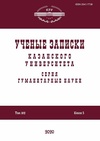Рубахи из пестряди с элементами выборного ткачества у народов Волго-Уральского региона (история формирования традиций)
Coarse motley shirts with the elements of discontinuous supplementary-weft weaving among the peoples of the Volga-Urals region (on the history of formation of the traditions)
Author(s): E.E. NechvalodaSubject(s): Museology & Heritage Studies, Customs / Folklore, Regional Geography, Ethnohistory, Cultural Anthropology / Ethnology, 17th Century, 19th Century, Inter-Ethnic Relations
Published by: Казанский (Приволжский) федеральный университет
Keywords: traditional costume; women’s shirts; coarse motley shirts; discontinuous supplementary-weft weaving; peoples of Volga-Urals region; interethnic interaction; sources of traditions;
Summary/Abstract: This research aims at specifying the territory and time of the establishment of traditions to decorate women’s shirts with discontinuous supplementary-weft weaving among the peoples of the Volga-Urals region, as well as at identifying the ethnic environment in which these traditions had their roots. Certain ethnographic, ethnoreligious, and ethnoterritorial groups of the peoples in the region acquainted with the tradition under study and the territory of its emergence were analyzed using the historical comparative method and taking into account the history of migrations of these ethnic groups, their neighborhood environments, and major vectors of their interethnic interactions. The results obtained reveal that during the early 20th century women’s shirts in the Volga-Urals region were made following two distinct traditions in using the elements of discontinuous supplementary-weft weaving as a decoration that differed over time and place of their formation. The earliest one is associated with decorating the coarse motley shirt along the lower edge with a sewn-in patterned ribbon made using the discontinuous supplementary-weft weaving technique. Among the Tatars of the Volga regions, this type of decoration appeared by the mid-17th century. In the Bashkir, Udmurt, and Mari costumes, such shirts were the borrowed element. Another tradition, to decorate shirts with supplementary-weft rosettes distributed evenly across the surface, became established no earlier than the mid-19th century within the area where the interactions between the Tatars and Bashkirs took place and where similar shirts were observed in the early 20th century among the Tatars, Bashkirs, Udmurts, and Maris, i.e. in the northwestern part of the Ufa Province and the adjacent northern and western territories. The results obtained can be used for further studies of traditional costumes of the peoples of the Volga-Urals region and their interethnic interactions.
Journal: Ученые записки Казанского университета. Серия Гуманитарные науки
- Issue Year: 163/2021
- Issue No: 6
- Page Range: 215-229
- Page Count: 15
- Language: Russian

